
LINKS
email meCabin Pages
Back to Index for Timberframe Cabin pages.
Back to First Timberframe Cabin page (April-August 2006).
Back to Second Timberframe Cabin page (September - December 2006).
Back to Third Timberframe Cabin page (January- May 2007).
Back to Fourth Timberframe Cabin page (Summer 2007).
Back to Fifth Timberframe Cabin page (Fall 2007).
Back to Sixth Timberframe Cabin page (Winter/Spring 2008).
Back to Seventh Timberframe Cabin page (Summer 2008).
Back to the Eighth Timberframe Cabin page (Fall/Winter 2008-9).
On to tenth Timberframe Cabin page (Fall/Winter - 2008-2009).
On to the Eleventh Timberframe Cabin page (Spring/Summer 2010).
On to the Twelfth Timberframe Cabin page (2011).
Forward to the Thirteenth Timberframe Cabin page (2012).
Forward to the Fourteenth Timberframe Cabin page (2013).
Forward to the Fifteenth Timberframe Cabin page (2014).
To the sixteenth Timberframe Cabin page (2015).
To the seventeenth Timberframe Cabin page (2016).
My Links to Other People's Timberframe sites.
Useful Offsite Info (Open in new Windows)
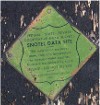 Weather at nearby Old Battle Monitoring Station.
Weather at nearby Old Battle Monitoring Station.
Weather Forecast for Encampment.
NOAH Weather Forecast for approximate cabin location from NOAH.
Southeast Wyoming Road Conditions.
Avalanche forecast for just south of here.
Link to Wyomingtalesandtrails site on are.
My Other Web Pages

Watching, Waiting, Hoping . . .
The image above is of Battle Lake which you can see from the road over the pass (Battle Highway/Highway 70) once you have gone a bit past the Continental Divide which crosses the highway at the pass. It is obviously from an old post card. The story goes that this is where Thomas Edison invented the carbon filament for lightbulbs, courtesy of a broken bamboo rod. So they say. If the card is to be believed the lake lies on the East side of the Divide, but I'm not so sure. I'll have to consult a map, but it seems to me it must be to the west in the Little Snake River drainage and not in the drainage feeding the North Platte. (I have now consulted a map and I seem to be right that the lake is to the West of the Continental Divide.) Since there isn't too much going on yet to provide me with photos to post, I'm including a link to the Battle Lake on Google earth. We'll see if I can make it work. This is a link to kmz file w link to Battle Lake in Google Earth . If your browser is correctly configured it should take you to Battle Lake in Google Earth.
And this is a photo of Battle Lake as it looked in the Summer of 2006 or so, along with the plaque telling the Edison tale:

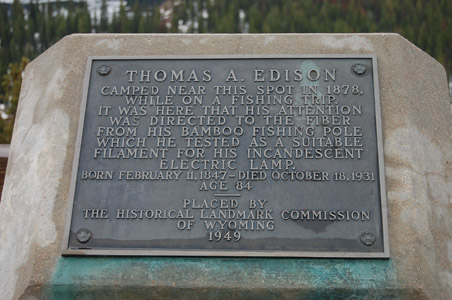
In any case, given that there is still 6 feet of snow near the pass (as of May 23 make that 5+ feet as of June 1) and that crews have not yet started clearing the road over the pass, the card, this old photo in a different season, and that link to Google Earth are all I have to show of the area for now. In the meantime we monitor the situation in hopes of a trip to the cabin where we can bring in some supplies without carrying them 6 miles over the snow on foot. There are various resources for that in the links on the sidebar if you wish to do the same.
Meanwhile I Was Working
With nothing else to do but wait at home I used the time to make stuff to haul to the cabin and install when I could. One project involved makng a storm window for the remainng window without one. Since that gets used for ventilation, even in winter, this one is designed to hinge out and fit over the screen. Rather than describe it I'll post another photo or two when I put it in. All of my storm windows are quarter inch thick tempered glass. Apparently many fire codes require tempered windows in areas that are vulnerable because fire can break untempered glass, letting the flames in. The story goes that if this did not happen many homes would be saved. I'm taking no chances so I'm doing it and doing it with thick glass. The photo below is of the newly primed storm window sash.
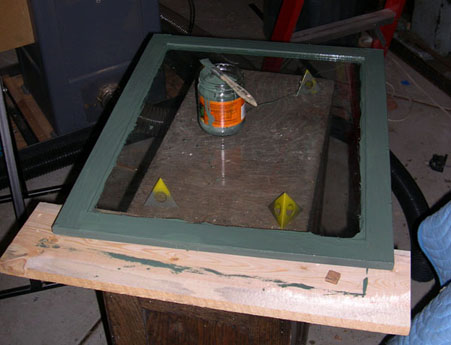
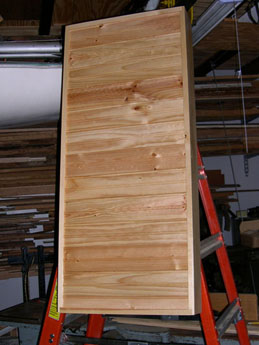
Another project involves a storage bin that I plan to hang under the loft between the joists. It will swing down and hopefully allow me to store things I need year round access too, without so much clutter in the cabin. This was made of pine with a beadboard bottom and then shellacked. Chances are I'll have a photo of the bin installed later on.
Oh Yeah. As of June 2, the main road is open! Snow is still above 4 feet deep.
Watched Snow Never Melts (Even in June)
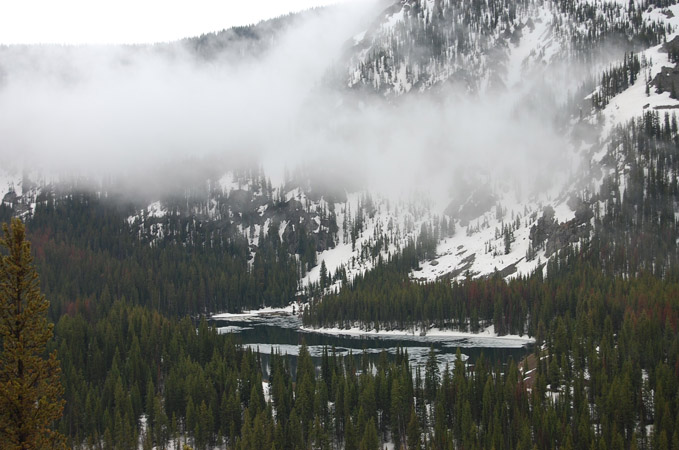
So the road was supposed to be open and the plan was to go to the cabin on June 7, haul in some stuff and get to work. As the above photo of Battle Lake on June 9 shows, this was not a very good plan. There was way too much snow on the ground to get anywhere close with the van. Instead we wound up staying with Alfred at his cabin and bringing what we could to his basement. This was harder than it sounded as we could not drive to Alfred's cabin either and there were 8 foot drifts across the road into which we'd sink a bit, but bars spots as well. Still we got most of what we wanted into his basement by making multiple trips back and forth.
Snow Damage
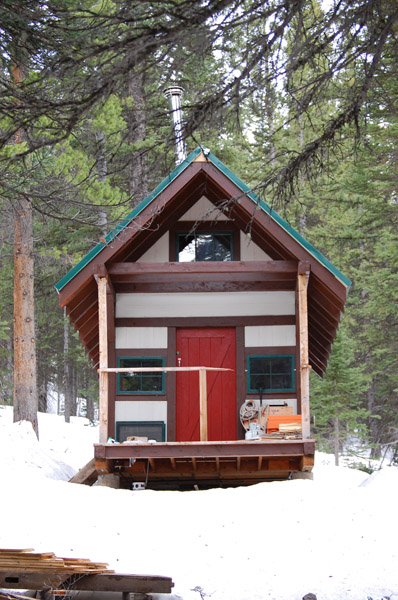
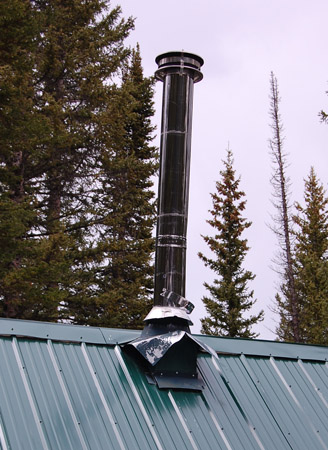
From there I hiked down the rest of the way to check the place out. I'm afraid the snow did some damage. You can see the chimney tilted a bit in the photo above and also that the roofing itself is pulled away at the peak. That should be no major concern. Also visible is damage to the porch railing, presumably from snow that fell from the roof above. That will take a couple of hours to fix, as well as some new wood and perhaps a more rigid method of attachement. The chimney is a bigger deal. As you can see in the photos, the new heavy duty support from last summer was destroyed. You can't see it here, but in addition to breaking the band the snow bent the angle.
It wasn't all bad news. Our creek was running well.
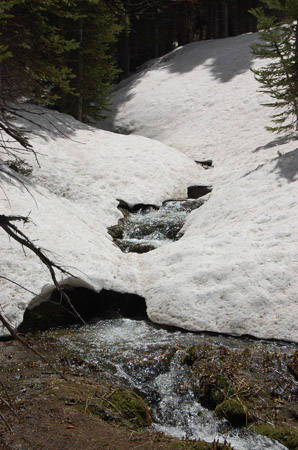
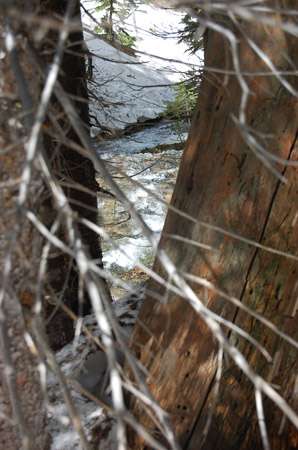
And while I was at the cabin site I did manage to install some newer style LED lights and a mirror above the sink.
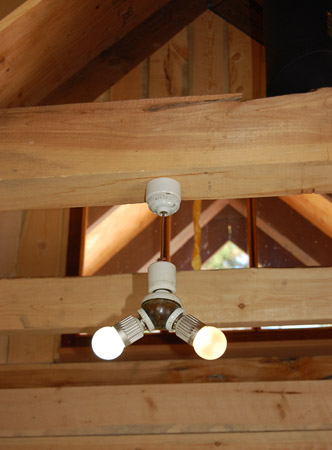
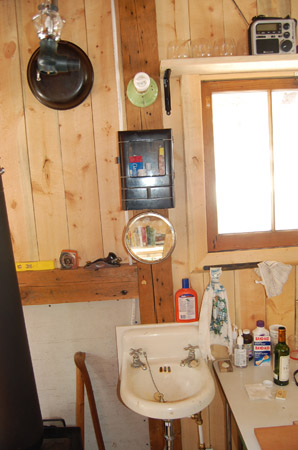
The plan had been to burn slash with snow on the ground for fire safety. Unfortunately there was too much snow and more snow, hail and rain fell at hourly intervals. Nothing was going to burn well. I helped Alfred with his plumbing at his place instead, and we headed home early.
Sights on the Way Home
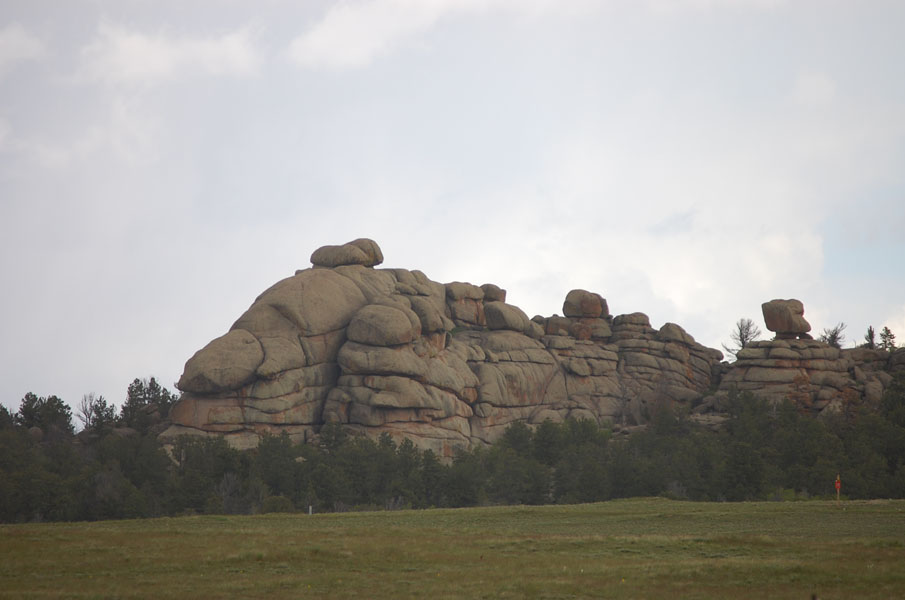 Those are the Sherman Mountains, known for their distinctive worn round shapes. These formations are known as Vedauwoo rock formations. Nearby is a well known tourist attraction, the Tree in the Rock, that was originally along the old Railroad route, which eventually was the route of Lincoln Highway, and then Interstate 80.
Those are the Sherman Mountains, known for their distinctive worn round shapes. These formations are known as Vedauwoo rock formations. Nearby is a well known tourist attraction, the Tree in the Rock, that was originally along the old Railroad route, which eventually was the route of Lincoln Highway, and then Interstate 80.
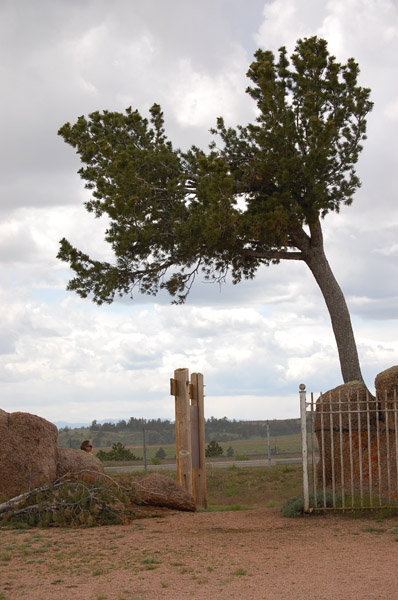
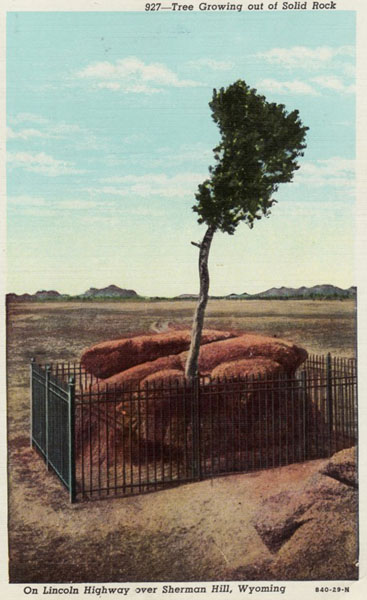

Burning and Looting, or rather Limbing and Burning
Not much to say here and not much to photograph. I drove back hoping to catch the weather with enough snow on the ground to make burning slash safe but with little enough that I could drive close by. That calculation came out OK. The dirt road in looked like this:
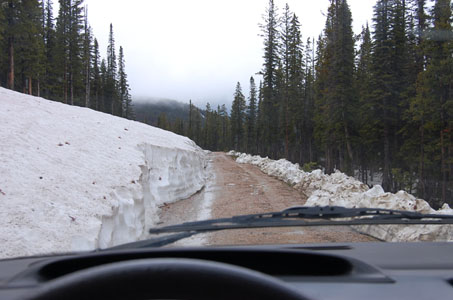
The burn barrel looked like this:
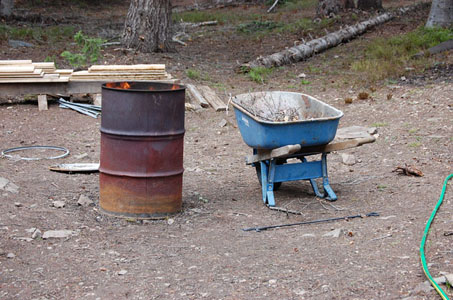 I did say there wasn't much to photograph, at least where the driving and burning are concerned.
I did say there wasn't much to photograph, at least where the driving and burning are concerned.
On the other hand there were some even more unphotographable events that were to my liking. I used computed GPS coordinates to try and find the corners of my lot with from the survey stakes for the whole private inholding. One came very close to an iron rod across the creek that I now regard as the default location for the Northwest corner of the property. And the other location was even further to the east than I'd originally thought. This is good news because we clearly own a portion of the permanent creek that we were told ran across the property. And we also own a portion of the once seasonal, but now seemingly permanent drainage creek that runs to the property along the access road and then down along the border between our lot and the next. Flows in this creek are now significant, since the neighbors built a trout pond that drains into the ditch beside the road - apparently increasing the flow of the spring that feeds the ditch. The incline across this property is steep, so it is a potential hydropower source (not that I need it) and it now holds trout - escapees from the neighbors.
Of course the main business was burning and chopping . . .
Odds and Ends (Lost Time is not Found Again).
Because I was burning in a barrel for safety, there were times I had to let thing burn without feeding them any further. This left brief periods for small projects without me needing to tend the flames. And given that time is short I put those times to use. One such project was to install the storm window that I'd made back in Lincoln. Recall that the purpose of this one is not so much to insulate as to make the whole cabin fire save. The idea is to cover each window with 1/4 inch tempered glass so that fires will not break windows and find a way inside. But the particular window in question adds ventilation, even in winter. So we needed a way to Open and close the storm window from inside and to leave the screen on at all times. The photos below show the solution as I conceived of it. The storm window opens and closes with a brass pull chain from inside. It goes over the screen. Here are a couple of photos.
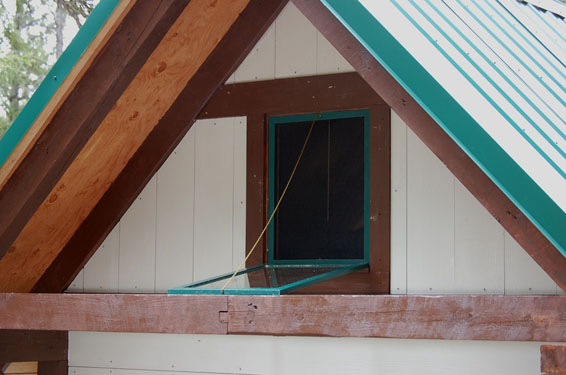
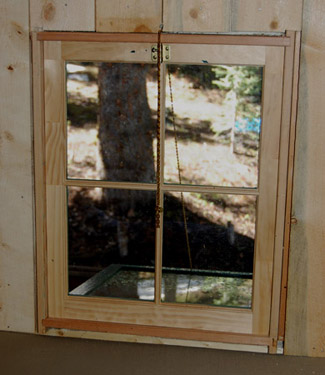
Another quick project was installing the storage bin I'd made in Lincoln. It fits nicely between the joists that hold up the sleeping loft. The idea is that if swings down to hold some stuff that I need all season access to, but which I don't want to put in the dresser where it is now. It seems to have worked as intended, though now I have to thinka bout what to put in it; it isn't like I don't have too much stuff that I want to use when I'm up here.
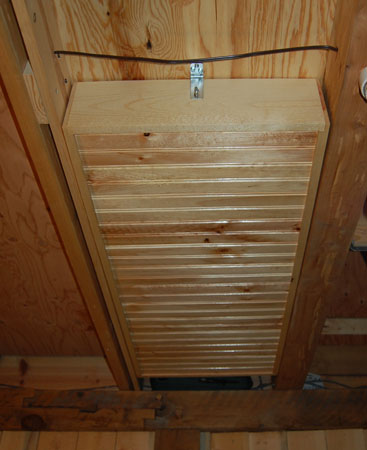
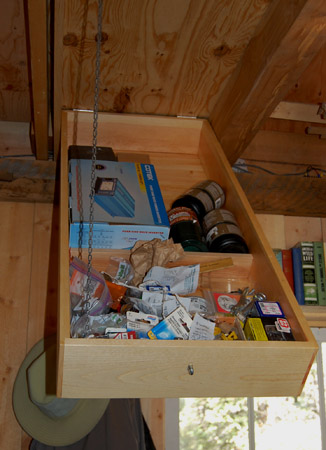
And there was some additional interior decorating, as it were. I retrieved the books I'd left at Alfred's on our last trip out and put them on the shelf. Since I'm a bookish person I tried to assemble some appropriate books for the locale. Several have Wyoming and wilderness themes. A couple are by local authors. "The Virginian" was set in a fictional Wyoming town, and then because of its popularity led to a Hotel named after the book. Some day I'll stay there. Anyway, here's a shot of the bookshelf:
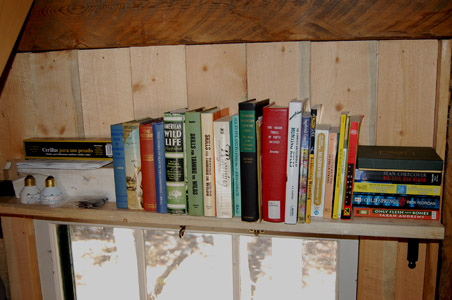
I also finally got the latch installed on the door so that we can shut it without locking it. Last year I had already ordered a forged old-style latch of the sort I'd seen in the Old Faithfull Inn, thought the part on the door frame works slightly differently. (Don't get me started on what they did to those very latch parts in the recent renovation of the Old Faithfull Inn . . .) It turned out that my door is thicker than these latches were designed for. I'm no blacksmith like my friend Wes, but I've watched him work and he's let me hit some hot metal now and again. And I do have an anvil and a couple of torches. So I took a piece of iron and banged on it to make the curved part with the thumblatch that goes through the door and is pinned to the outside handle. The photo on the left shows tha part after I worked on it, along with the other main part. The next photo shows the outside handle and thumb latch installed (paint needs touch-up), and the third shot is the inside view. It works well and it was what I'd been hoping for. Next trip I'm hoping to add forged strap hinges to match.

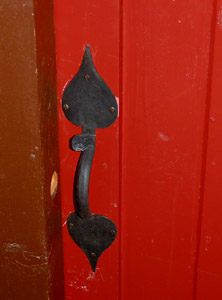
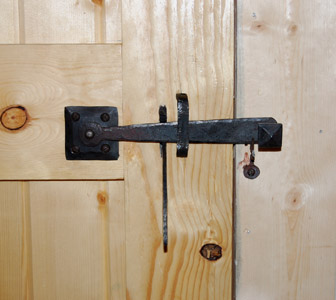
I also added a framed print from Glacier National Park in Montana. When I was 17 all of my friends (and many acquaintances) were planning on doing cool things the summer after graduation. So I had to have a plan too. My story was that I was going to go west to backpack in Glacier National Park. It mattered little that I had never backpacked in my life (though I had bike camped). Nor that I had no hiking boots or backpack. That was my story and I was sticking to it. I bought a Frostline backpack kit and sewed it myself on my Mom's old sewing machine that my Dad and I had sewed a tent fly for my tent with. (Eventually I'd get around to a sleeping bag partly on that machine.) And I got a pair of Danner boots for my graduation present. From there I set out hitch-hiking to Montana to Glacier Park. I had no real idea what I was doing. I knew where the park was, and I'd done a slight bit of hitchhiking previously, but nothing overnight. But highway 90 went through Rockford and wound up in Montana. I think I took I-94 across Minnesota North Dakota and Montana. In any event, I eventually arrived at the park.
Even in the 70s you needed a permit with an itenerary for backcountry trips. I went into the office and got a permit. The names Lake Ellen Wilson, still rings a bell. And the fact that the first day's hike was 9 miles long and that the incline was steep. And the boots were new. I remember hiking past a Chalet and eventually getting to the site I'd gotten the permit for. Then another hike to another site. And so on.
In any case, I'm pretty sure I went by the falls in the photo. The photo labels them as "Trick Falls" and the credit is to Glacier Studios. The falls are now known as Running Eagle Falls, and that name may in fact be older than the one on the photo. The reason for the "Trick" name is that there is one falls in front of another that blocks the view of the second one during certain seasons. They seem to have been on the same route past the Chalet that I was on. And I think I remember them, though it was many years after the name change. The photo print is probably from the 30s to 50s. Checking on the internet the Falls are between two lakes I recall hiking to. Anyway, that all is supposed to explain why I bought it at a garage sale, framed it, and thought it appropriate for the cabin. Here's a shot of it on the wall:
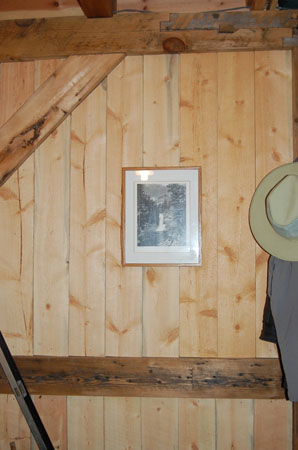
That backpacking/hitchhiking trip was one of many adventures and an important one in terms of what it led to. I probably put in more than 100,000 miles of hitchhiking after that trip. I learned how to live on nearly no money and travel. I ran into lots of people I would never have met otherwise and probably would have avoided if I had a choice. And I survived their acquaintance with no damage. I figured out how to keep up my end of a conversation with someone who had nothing at all in common with me, and I figured out that you could sleep almost anywhere where no one thought no one would want to sleep. I learned that your could get away with a lot if you just claimed you knew what you were doing. That last bit matters a lot, though as I get older I find myself less inclined to say I know what I'm doing about anything of any substance.
I went on several backpacking trips of some duration after that one, including parts of the Pacific Crest and Appalacian trails. But those hiking trips were with friends, as opposed to by myself. The boots nearly permanently deformed my feet. Eventually, I got lazy and mostly car-camped. I once got back to Glacier some years later, as I was leaving Oregon for graduate school. That trip was car-camping and in a VW squarebackfollowing Going to the Sun Road. That second trip to Glacier took me down to Yellowstone, for the first of many times, and Yellowstone is now one of my favorite places in the world.
Even though there were many intervening trips over many intervening years that first trip to Glacier has everything to do with the cabin. In some important way it led to my love of mountains and water and to my getting some land out here to spend time with both. No doubt that is more than you wanted to know, but if you just look at the pictures you can skip my text.
Here's a shot that should be of interest once you know what it is. Recall last year I had installed a piece of angle iron to support the chimney better. And recall that on the previous visit the strap that held the angle iron to the chimney had snapped under the wieght of the snow (there's a photo above). And the angle iron had also somehow bent. I went up on the roof this trip for a close inspection. I'm going to need to build a taller chase. And it better be designed to keep the snow from tugging on the chimney better because this is what the snow did to the angle iron:
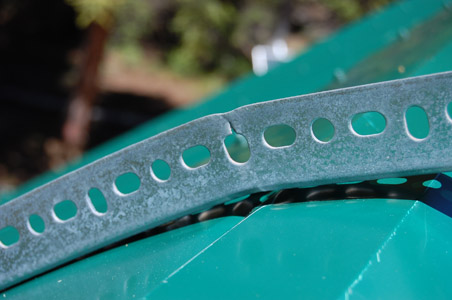
Wildlife
When I got up here this time I was the only one in the entire area spending the night. This meant that a deer and I surprised each other on the first evening, and that I surprised a couple of Elk the first morning. Unfortunately I didn't grab the camera quicly enought to document either of those encounters, and neighbors with 4WD off road vehicles showed up the second day to scare the wildlife. (Nothing wrong with the neighbors, but the noise does put the wildlife off.) So I haven't got a decent photo to show.
On the other hand, wildlife in town comprised a parade in conjunction with the Woodchopper's Jamboree:
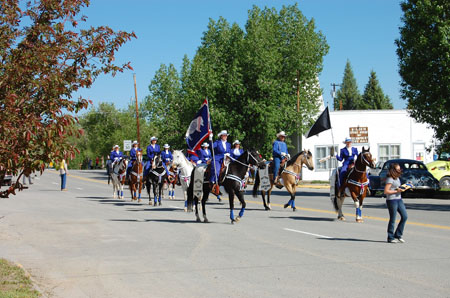
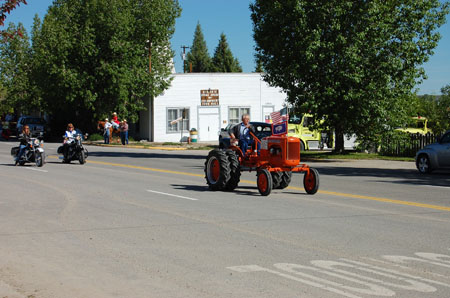
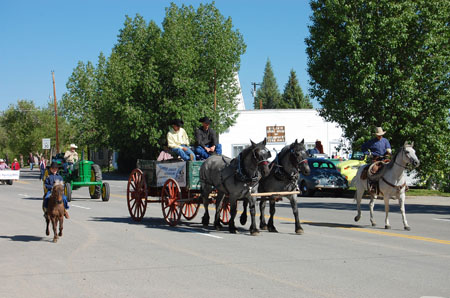
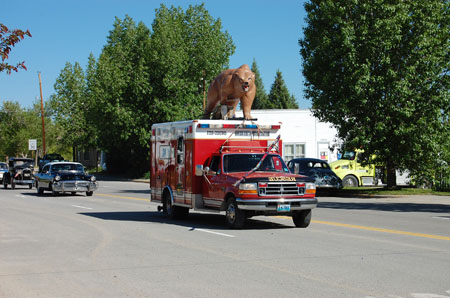
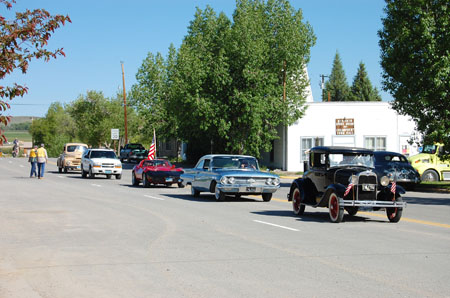
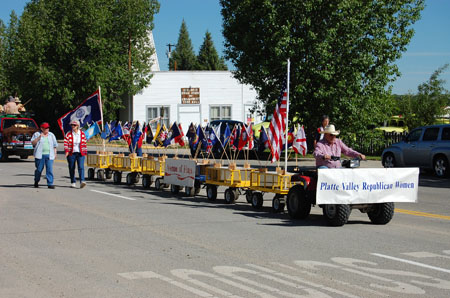
If that last photo is any guide it looks like the Republicans are in retreat even in Carbon County, Wyoming. I guess the two women walking alongside the "float" might be members. Not sure about the driver.
Later in the visit I did manage a couple of evening walks after the neighbors with the 4WDs had taken off. I didn't manage to photograph the deer I'd seen the other day, though I saw it again. But I did get a couple of other decent shots of the wild. The first photo is in the evening sun after afternoon rain and hail. It is just across the creek downhill from the cabin, but not yet in the national forest. The tree is a young lodgepole pine. The second photo is of a hummingbird sitting on a neighbor's deck. Not sure why it sat so long, but just as my camera ran out of memory it flew off. The third is of a woodpecker-like bird I saw the day I left.
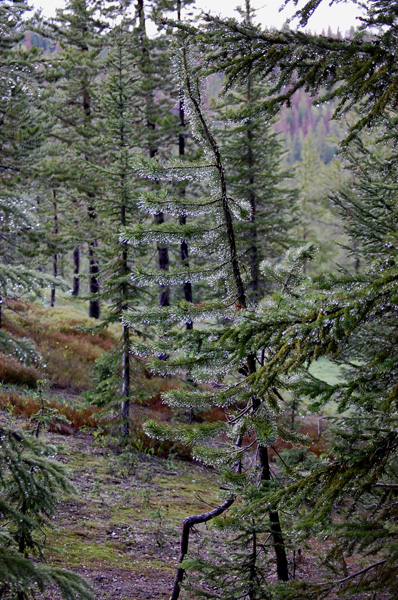
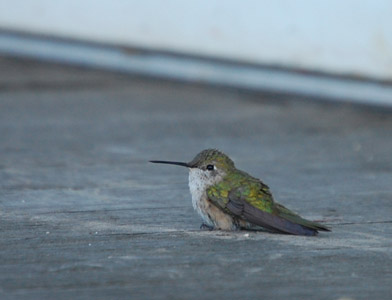
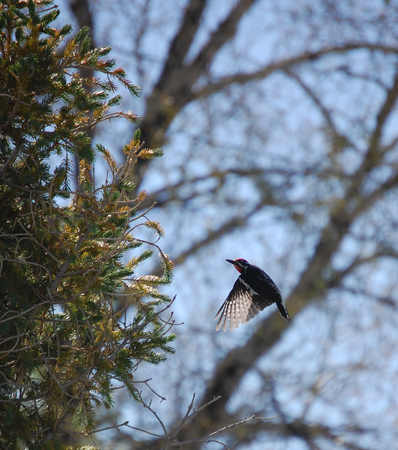
Nice to make the NY Times Without Robbing a Bank
As I noted over the winter I've added a link to the sidebar to sites with interesting cabin and timberframe content. One of those links is to a blog by Lou Ureneck, a professor of journalism at Boston University, and now a timberframe cabin builder. He's chronicling that project on his blog for the New York Times, which runs under the title "From the Ground Up". Just last week Lou ran a short interview with me about this project in his blog, using the title " Q & A With Mark Van Roojen, a Philosophy Professor and Cabin Builder". Lou's project is going to be very nice when it is done, and there are a number of knowledgeable commentators in the comment sections as well, so you might enjoy checking out the whole thing.
Smoke, Soot and Chimney Rehab
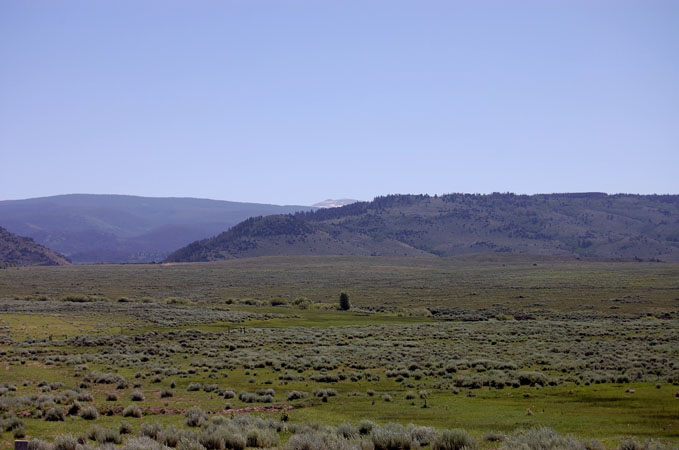
This has been a very wet year in much of Wyoming, as you might infer from the green hillsides and meadows in the photo of the Snowy Range (just across the North Platte) above. Good weather to burn slash from limbing, and convenient since there was much left to burn from the previous trip. So we spent four days around the July Fourth weekend cutting and burning limbs, and repairing the chimney once more. The photos below are of Jenny working on the former project:
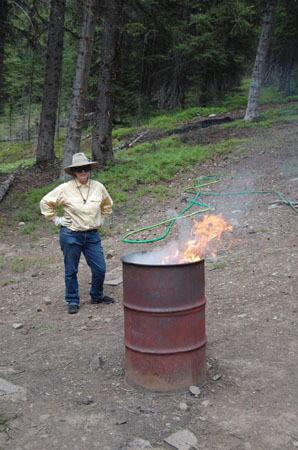
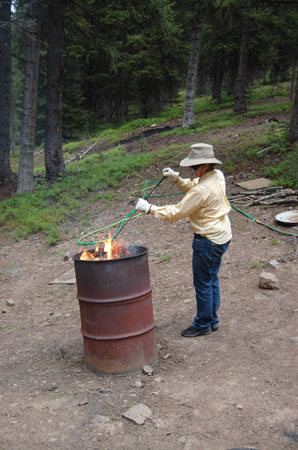
You may recall that the snow once again trashed the chimney. If the snow was going to break support straps and bend angle iron mere repair is not going to be a sustainable long-term strategy. A re-design was in order. I decided to extend the supporting box around the chimney on the roof to stand well proud of the peak. This required stripping the roofing and flashing around the chimney, building a new box around the old one and extending above it, better securing the chimney in its new home in that box, and more securely fastening the new box to the roof. I also decided to run roofing from the opposite side of the roof to the new chimney box so that there would no longer be a place for the snow to accumulate between the box and the peak. The photos below show the job and include a photo of the damage, the stripped roofing and old box, the new box with a view of the interior strap supporting the chimney, and the finished product.
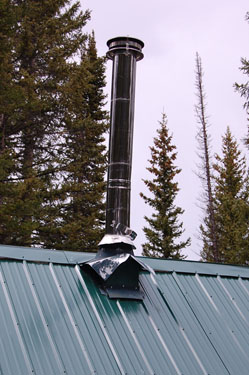
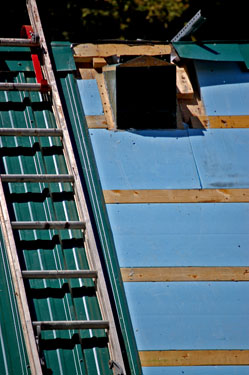
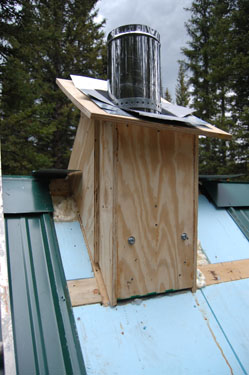
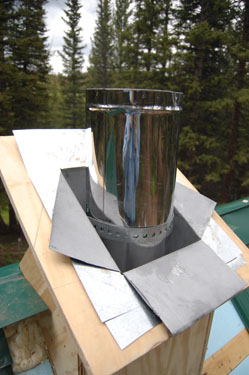
And here is the finished project:
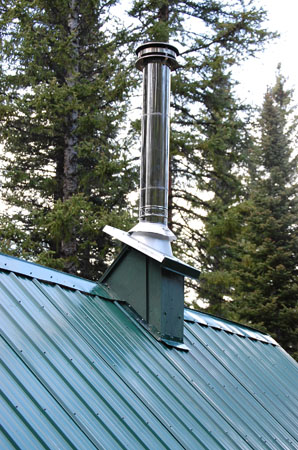 We can hope the third time is charm.
We can hope the third time is charm.
On the way home the Snowies showed us this view and Jenny got a decent shot of me looking tired and bedraggled:
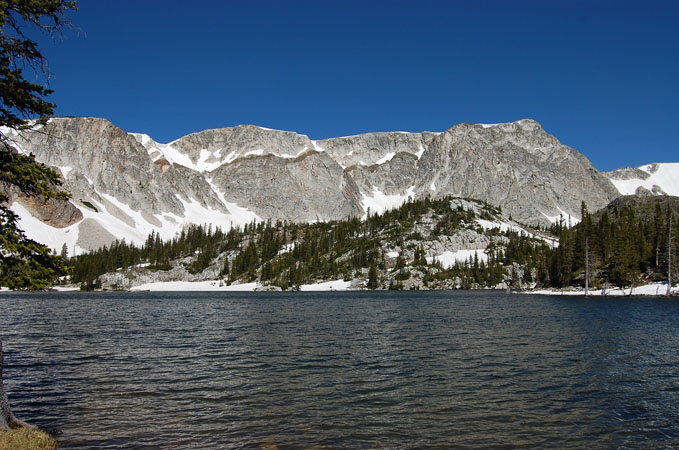
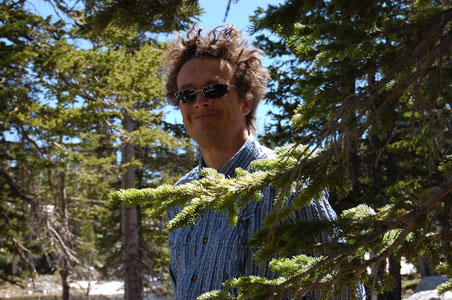
Logging
Jack Roberts has been logging since he was 13, and his father and grandfather were loggers as well. Jack's grandfather logged the area for the Crow Company in the 1930s, and may well have cut logs on this very land. In any case, Jack comes highly recommended by my neighbor Alfred, and quickly showed me why. In about 3 hours he felled 22 trees, including some that had to fall in just the right place. For those he climbed the tree to attach ropes which were then run through a snatch block with a pulley that we chained to trees in the direction we wanted the cut tree to fall. Then he cut while I pulled the rope. In each of those cases the trees went where they were supposed to. For the remaining trees we relied on Jack's skills at controlling the direction of fall by making cuts in just the right place. Only one went anywhere different than hoped, and even that one landed with a greater margin of safety between it and the spring box than absolutely desired.
Due to some problems with camera exposure, the photos below are not what I'd hoped for, but they do convey much of the process. The last photo in the series shows Jack in the tree attaching ropes to pull it past the cabin about 5 feet away. That plan came off without a hitch (so to speak).
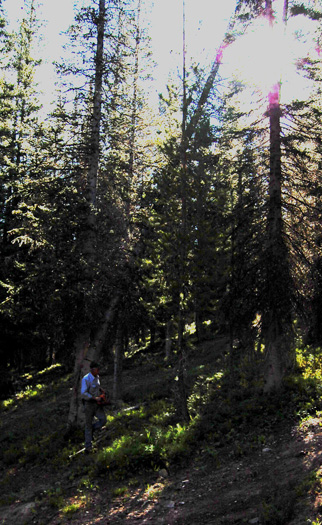
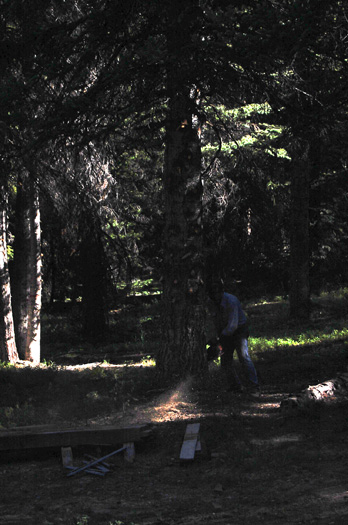
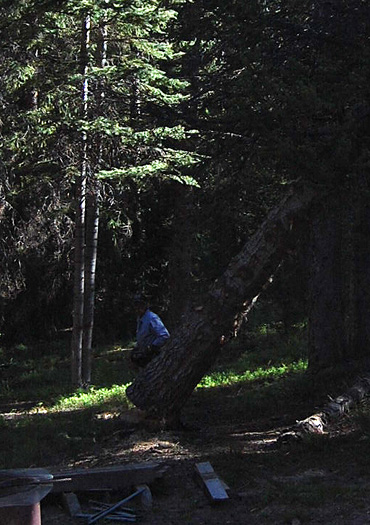
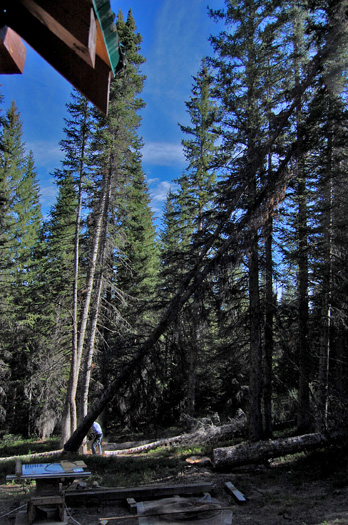
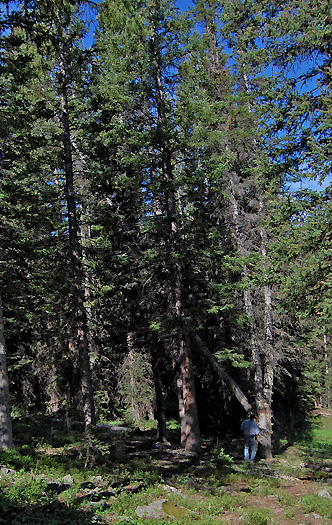
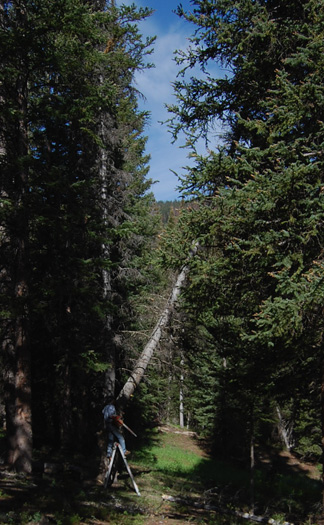
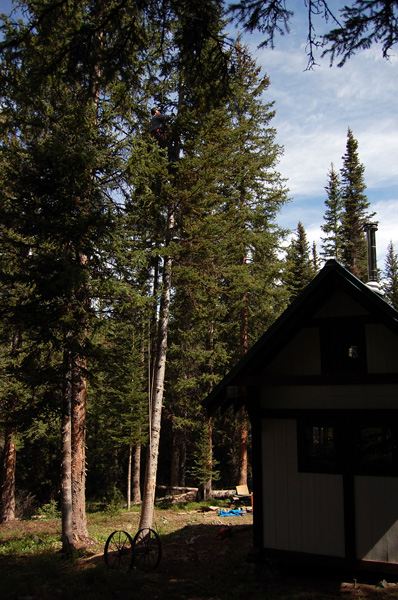
With work completed Jack pulled a couple of beers out of his cooler and told me about logging in the area, plant identification, tree life-cycles and much more besides. Then after an hour or so loaded his dogs into his truck and left me to limbing the fallen trunks and felling a few remaining small trees. Needless to say there were many limbs to clean up. My neighbor Mike helped by hauling some of the results to the dump, but there is still much to do. After felling one marked but missed medium sized tree, I felt a little more like a logger. At least enough so that the picture below doesn't seem too misleading. I limbed but did not fell the tree I'm sitting on. Judging from the rings it is about 80 years old which fits with the information that this land was last logged in the 1930s.
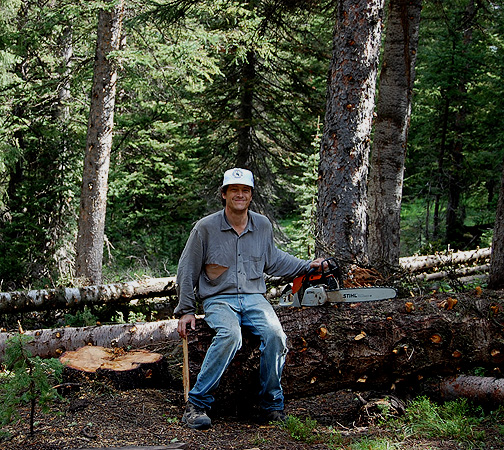
The result of all this labor was some decent fire breaks around the cabin without getting rid of too many trees or even all of the trees near the cabin. Those that remain within 70 feet will have to be limbed up ten feet off the ground to prevent ground fires from crowning and to allow fire crews to feel safe fighting any fire that might threaten. But there are still many many unlimbed trees beyond that distance, and a good number of limbed healthy trees within that radius. As you can guess, this means we still have our work cut out for us. But in the meantime we do have this nice view from within the cabin as a result of taking out two trees, one dead and one problematic:
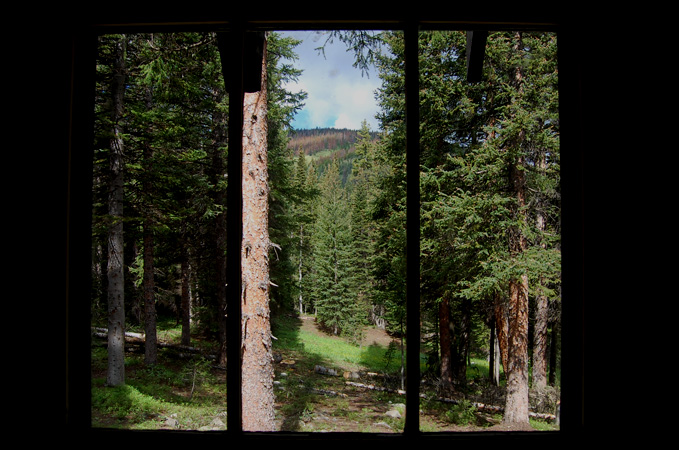
I also managed to work on the cabin door to install some hinges more to my liking than the original ones I started with. The result is shown below.
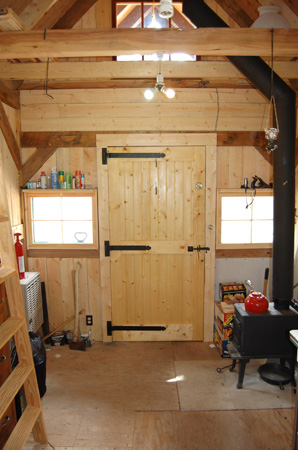
Encouraging Test Results
On the last day of my previous visit at the end of July I took a water sample from the spring box back to be tested by the local sate water folks who are kind enough to do that even if my well is out of state. The results for coliform bacteria and e coli came in the mail this weekend and both results were zero. I should get a nitrate reading as well soon. And I'm thinking of getting the state of Wyoming to do all sorts of extra tests for minerals of and such. That will set me back over a hundred bucks, but it will add to my confidence about using water. In any event, so far so good.
Skidding, Limbing and Hauling Slash
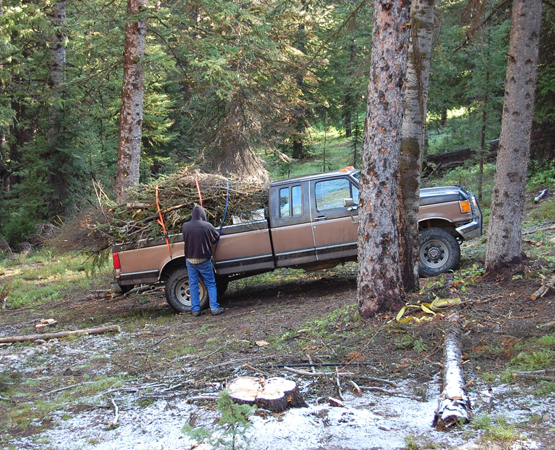
I spent another week of clean up time at the cabin in early August after the RoME Congress in Boulder, where I gave a paper. The process involved limbing the downed trees, cutting them to usable lengths of about 22 to 26 feet, skidding them into a pile, and then hauling limbs to the dump. The photo above shows my neighbor Mike's truck with one load of limbs after they have been strapped down for the trip to the dump. We must have done ten loads or so. Not much to see here besides the full truck.
Skidding logs is a bit more visually interesting. We used a log chain to attach the trunks to the hitch om Mike's massive old Ford truck with a 450 engine and 4WD. Then we towed them up the hill to a location where I wanted the pile to go for now. Some of these were rolled into place and others were rolled over on top of them using brute force, occasionally the truck chain, and a remarkably handy logging tool known as a peavey. Essentially this is a handle with a cleat that digs in to hold the log so that the handle can lever it. Thge photos below show the skidding and the pile. I'm not sure yet, but I may wind up using many of these logs for floor joists in a somewhat larger cabin projected for the next decade or so after I'm done with this one. Then I'll use somewhat nicer logs yet (most of these are Balsam/sub-alpine fir) of pine or spruce for the walls above. But we'll see.
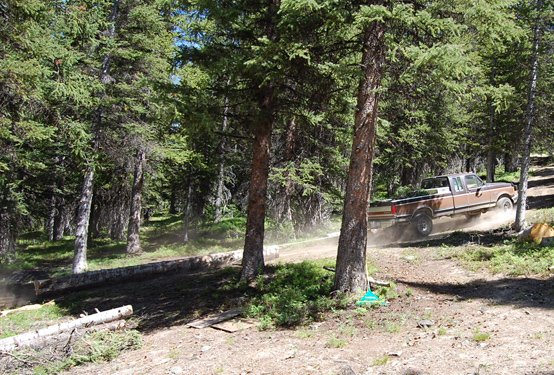
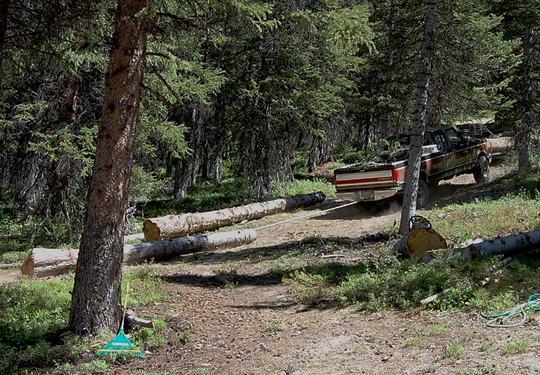
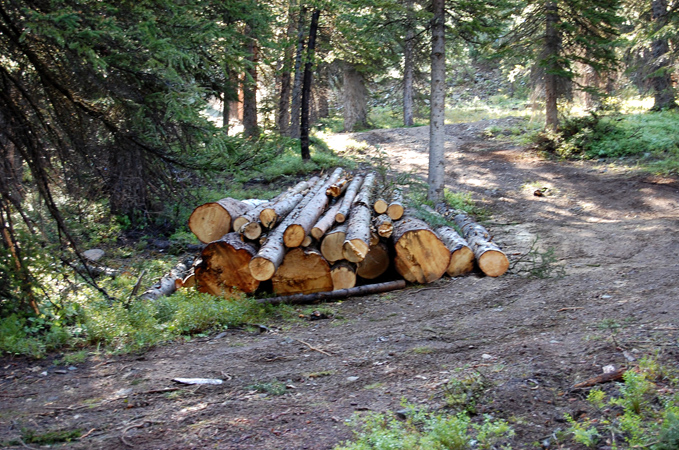
The Snows of August
Of course the work was not uninterupted. In addition to a pleasant visit from my colleague David with whom I fished the Encampment on one day of the week, and also a trip to the state lab in Laramie to deliver a water sample for testing for heavy metals, the weather sometimes made work difficult. One afternoon looked like this:
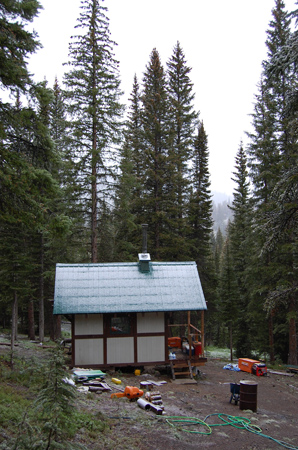
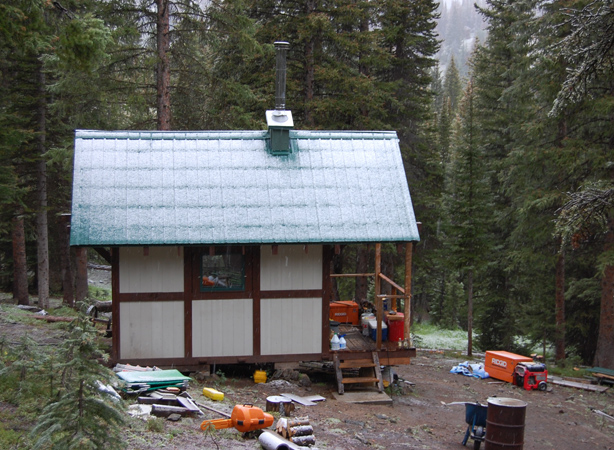
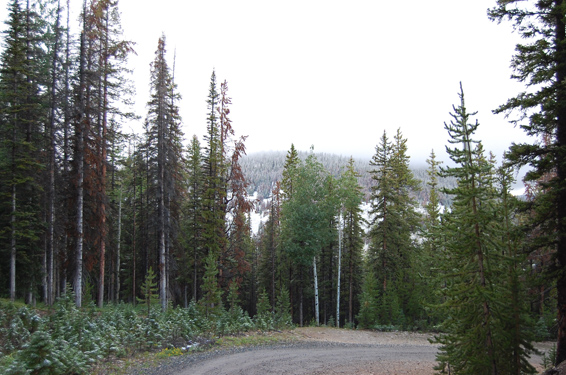
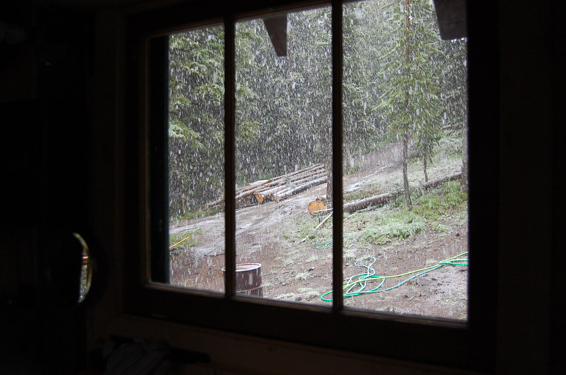
The Spring Water Tests Are Back
And now a bit over a week later we have the latest water test results. All of the various substances tested for are at levels "suitable" for human consumption and most of them are below 2 to 15% of the maximum levels recommended by the EPA. The water is quite soft (as Jenny notes when she washes her hair in it) and my guess is that it is much healthier than the water we get in Lincoln from the tap. Yippie! Next time we're up we will fill the cabin tank with spring water for the winter and be ready for what comes over the cold season.
Labor Day Weekend
Labor day weekend was a bit on the late side this year. We drove out and spent 3 nights at the cabin. On the first morning we met with Joe of the Fire Department to get advice on what all we still needed to do to finish up our end of the fire fuels mitigation grant contract with the state. It turned out we had done what was needed for him to sign off on the paperwork, so we will soon get a check to partly reimburse us for time and expenses. He was very helpful throughout the process in giving advice and his take on what it was important to do to make the cabin fire safe, and also to keep some of the trees we have. We still have a bit of slash to burn, and he suggested doing a bit more limbing further yet downhill from the cabin. But we've done what we need to get the check this year. I'd been afraid it would be next summer before we'd be eligible, so this was unexpected good news.
To get an idea of the work involved, the before and after photos below give you some sense of the amount of trees cut and limbls limbed, but only some sense. Cameras have a hard time conveying differences over such a wide area.
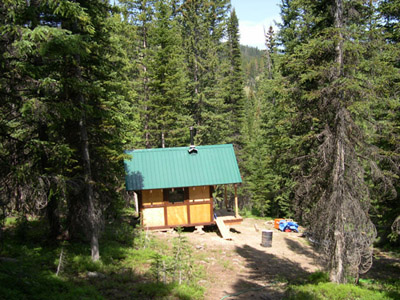
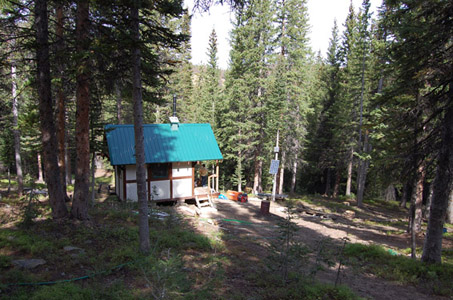
Now that our water test came back positively we were also able to fill the tank inside the cabin with enough spring water for the winter season. And as an added living off the land bonus we found edible mushrooms on the property, one of which was the king bolete we harvested and grilled that is pictured below. We were able to do this with the help of Mushrooming Without Fear by Alexander Schwab, which we had been lucky enough to purchase in Laramie on the way up. It tasted very good grilled over a barrel full of slash.
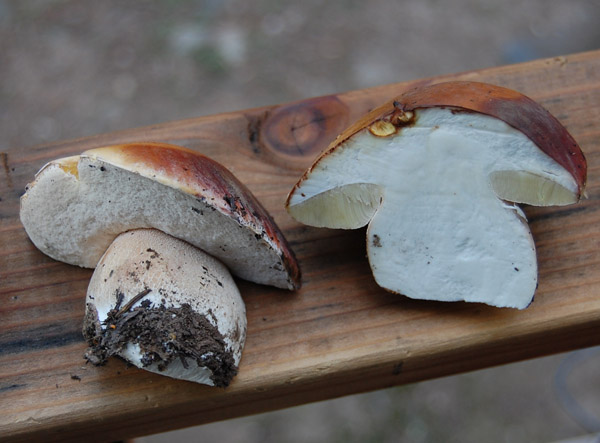
Links To My Other Cabin Pages
Back to Index of the Timberframe Cabin pages.
On to tenth Timberframe Cabin page (Fall/Winter - 2009-2010).
Back to first Timberframe Cabin page (April-August 2006).
Back to Second Timberframe Cabin page (September - December 2006).
Back to third Timberframe Cabin page (January - May 2007).
Back to the fourth Timberframe Cabin page (Summer 2007).
Back to the fifth Timberframe Cabin page (Fall 2007).
Back to the sixth Timberframe Cabin page (Winter/Spring 2008).
Back to the seventh Timberframe Cabin page (Summer 2008).
Back to eighth Timberframe Cabin page (Fall/Winter - 2008-2009).
On to tenth Timberframe Cabin page (Fall/Winter - 2008-2009).
On to the eleventh Timberframe Cabin page (Spring/Summer 2010).
On to the Twelfth Timberframe Cabin page (2011).
Forward to the Thirteenth Timberframe Cabin page (2012).
Forward to the Fourteenth Timberframe Cabin page (2013).
Forward to the Fifteenth Timberframe Cabin page (2014).
 Back to My Homepage.
Back to My Homepage.
 Fishing with Robert.
Fishing with Robert. Trout Unlimited National Website.
Trout Unlimited National Website. My Philosophy Page.
My Philosophy Page.
 My Woodworking Page.
My Woodworking Page.
 My Workbenches Page.
My Workbenches Page.
 My Old House Page.
My Old House Page.
 My Kitchen Cabinets Page.
My Kitchen Cabinets Page.
 The Bathroom Remodel Page.
The Bathroom Remodel Page.
 My Father's Milling Machine.
My Father's Milling Machine.